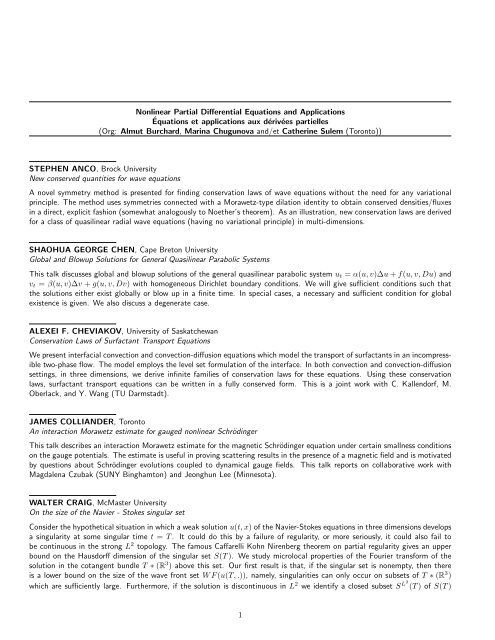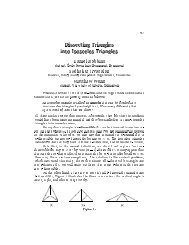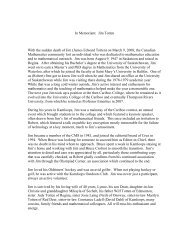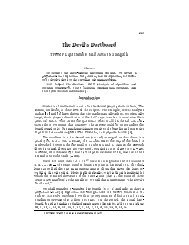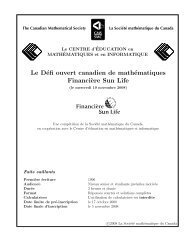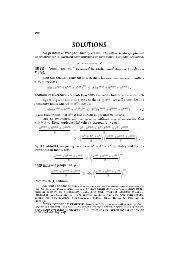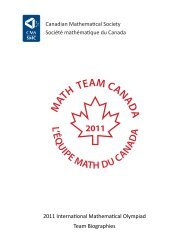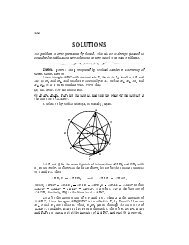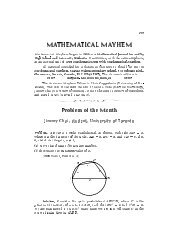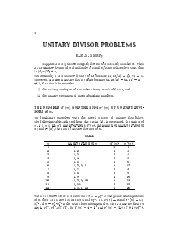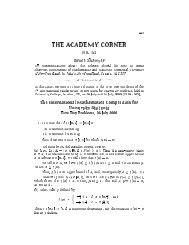Nonlinear Partial Differential Equations and Applications Équations ...
Nonlinear Partial Differential Equations and Applications Équations ...
Nonlinear Partial Differential Equations and Applications Équations ...
You also want an ePaper? Increase the reach of your titles
YUMPU automatically turns print PDFs into web optimized ePapers that Google loves.
<strong>Nonlinear</strong> <strong>Partial</strong> <strong>Differential</strong> <strong>Equations</strong> <strong>and</strong> <strong>Applications</strong><br />
<strong>Équations</strong> et applications aux dérivées partielles<br />
(Org: Almut Burchard, Marina Chugunova <strong>and</strong>/et Catherine Sulem (Toronto))<br />
STEPHEN ANCO, Brock University<br />
New conserved quantities for wave equations<br />
A novel symmetry method is presented for finding conservation laws of wave equations without the need for any variational<br />
principle. The method uses symmetries connected with a Morawetz-type dilation identity to obtain conserved densities/fluxes<br />
in a direct, explicit fashion (somewhat analogously to Noether’s theorem). As an illustration, new conservation laws are derived<br />
for a class of quasilinear radial wave equations (having no variational principle) in multi-dimensions.<br />
SHAOHUA GEORGE CHEN, Cape Breton University<br />
Global <strong>and</strong> Blowup Solutions for General Quasilinear Parabolic Systems<br />
This talk discusses global <strong>and</strong> blowup solutions of the general quasilinear parabolic system u t = α(u, v)∆u + f(u, v, Du) <strong>and</strong><br />
v t = β(u, v)∆v + g(u, v, Dv) with homogeneous Dirichlet boundary conditions. We will give sufficient conditions such that<br />
the solutions either exist globally or blow up in a finite time. In special cases, a necessary <strong>and</strong> sufficient condition for global<br />
existence is given. We also discuss a degenerate case.<br />
ALEXEI F. CHEVIAKOV, University of Saskatchewan<br />
Conservation Laws of Surfactant Transport <strong>Equations</strong><br />
We present interfacial convection <strong>and</strong> convection-diffusion equations which model the transport of surfactants in an incompressible<br />
two-phase flow. The model employs the level set formulation of the interface. In both convection <strong>and</strong> convection-diffusion<br />
settings, in three dimensions, we derive infinite families of conservation laws for these equations. Using these conservation<br />
laws, surfactant transport equations can be written in a fully conserved form. This is a joint work with C. Kallendorf, M.<br />
Oberlack, <strong>and</strong> Y. Wang (TU Darmstadt).<br />
JAMES COLLIANDER, Toronto<br />
An interaction Morawetz estimate for gauged nonlinear Schrödinger<br />
This talk describes an interaction Morawetz estimate for the magnetic Schrödinger equation under certain smallness conditions<br />
on the gauge potentials. The estimate is useful in proving scattering results in the presence of a magnetic field <strong>and</strong> is motivated<br />
by questions about Schrödinger evolutions coupled to dynamical gauge fields. This talk reports on collaborative work with<br />
Magdalena Czubak (SUNY Binghamton) <strong>and</strong> Jeonghun Lee (Minnesota).<br />
WALTER CRAIG, McMaster University<br />
On the size of the Navier - Stokes singular set<br />
Consider the hypothetical situation in which a weak solution u(t, x) of the Navier-Stokes equations in three dimensions develops<br />
a singularity at some singular time t = T . It could do this by a failure of regularity, or more seriously, it could also fail to<br />
be continuous in the strong L 2 topology. The famous Caffarelli Kohn Nirenberg theorem on partial regularity gives an upper<br />
bound on the Hausdorff dimension of the singular set S(T ). We study microlocal properties of the Fourier transform of the<br />
solution in the cotangent bundle T ∗ (R 3 ) above this set. Our first result is that, if the singular set is nonempty, then there<br />
is a lower bound on the size of the wave front set W F (u(T, .)), namely, singularities can only occur on subsets of T ∗ (R 3 )<br />
which are sufficiently large. Furthermore, if the solution is discontinuous in L 2 we identify a closed subset S L2 (T ) of S(T )<br />
1
on which the L 2 norm concentrates at this time T . We then give a lower bound on the microlocal manifestation of this L 2<br />
concentration set, which is larger than the general one above. An element of the proof of these two bounds is a global estimate<br />
on weak solutions of the Navier-Stokes equations which have sufficiently smooth initial data.<br />
MAGDALENA CZUBAK, SUNY Binghamton<br />
On some properties of the Navier-Stokes equation on the hyperbolic space.<br />
Contrary to what is known in the Euclidean case, finite energy <strong>and</strong> finite dissipation solutions to the Navier-Stokes equation<br />
on a two dimensional hyperbolic space are nonunique. We review the nonuniqueness result <strong>and</strong> discuss possible ways to arrive<br />
at uniqueness of solutions in the hyperbolic setting. This is based on joint works with Chi Hin Chan <strong>and</strong> Pawel Konieczny.<br />
MOHAMMAD EL SMAILY, Carnegie Mellon University <strong>and</strong> Instituto Superior Tecnico<br />
Speed up of Traveling Fronts by Large Advection<br />
Pulsating traveling fronts are solutions of a reaction-advection-diffusion equation in an unbounded heterogeneous periodic<br />
framework. Having a KPP reaction (after Kolmogorov, Petrovsky, Piskunov), it is well known by now that traveling fronts<br />
exist with a minimal speed c ∗ . The models describe population dynamics in a periodic framework. In the homogeneous case,<br />
where the reaction is f(u) = u(1−u), the minimal KPP speed is exactly equal to 2. In the generalized framework, the minimal<br />
speed has a variational formulation involving elliptic eigenvalue problems which was proved by Berestycki, Hamel, Nadirashvilli,<br />
<strong>and</strong> earlier by Weinberger in a slightly more particular framework. In this talk, I will describe the asymptotic behavior of the<br />
KPP minimal speed within a large drift. These problems have been widely investigated in the last 10 years (L. Ryzhik, A.<br />
Novikov, A. Zlatoš, F. Hamel, H. Berestycki, N. Nadirashvilli <strong>and</strong> many others). After showing the asymptotic regime in any<br />
space dimension N via a variational quantity involving first integrals of the advection field, I will give a Sharp Criterion for the<br />
linear speed up of the fronts by the drift term in the 2D case. This talk is based on joint work with Stephane Kirsch.<br />
MOSTAPHA FAZLY, UBC<br />
Liouville-type theorems for some elliptic equations <strong>and</strong> systems<br />
In this talk, we consider the problem of non-existence of solutions for some basic elliptic equations <strong>and</strong> systems with weights.<br />
Starting with Henon-Lane-Emden system, we present a Liouville-type theorem for bounded solutions in dimension N=3 as<br />
well as the statement for the full Henon-Lane-Emden conjecture in higher dimensions. Since systems are normally much more<br />
complicated than equations, in higher dimensions we back to single equations (both second order <strong>and</strong> fourth order) to prove<br />
such theorems under some additional assumptions on solutions. This work has been done under supervision of N. Ghoussoub.<br />
EHSAN KAMALINEJAD, University of Toronto<br />
Gradient flow methods for thin-film <strong>and</strong> related higher order equations<br />
We will discuss recent results on a class of higher-order evolution equations that can be viewed as gradient flows on the space<br />
of probability measures with respect to the Wasserstein metric. The simplest of these equations is the thin-film equation<br />
∂ t u = ∂ x (u∂xu), 3 which corresponds to the Dirichlet energy. We will consider questions of existence <strong>and</strong> uniqueness of these<br />
gradient flows. A key probem in the analysis is the lack of convexity of the relevant energy functionals.<br />
(Joint work with Almut Burchard).<br />
XIAO LIU, University of Toronto<br />
Numerical simulation for Derivative <strong>Nonlinear</strong> Schrodinger Equation<br />
We present the numerical simulation of generalized Derivative <strong>Nonlinear</strong> Schrodinger Equation (gDNLS):<br />
iφ t + φ xx + i|φ| 2σ φ x = 0.<br />
2
In the case of σ = 1, it describes the long wavelength dynamics of dispersive Alfven waves propagation. We observe that for<br />
σ > 1, solutions may develop a singularity after a finite time, <strong>and</strong> we give a precise form of the blow up rate <strong>and</strong> the solution<br />
profile.<br />
ROBERT MCCANN, University of Toronto<br />
Higher-order asymptotics of fast diffusion in Euclidean space: a dynamical systems approach.<br />
With Denzler <strong>and</strong> Koch, we quantify the speed of convergence <strong>and</strong> higher-order asymptotics of fast diffusion dynamics on<br />
R n to the Barenblatt (self similar) solution. Degeneracies in the parabolicity of this equation are cured by re-expressing the<br />
dynamics on a manifold with a cylindrical end, called the cigar. The nonlinear evolution semigroup becomes differentiable with<br />
respect to Hölder initial data on the cigar. The linearization of the dynamics is given by the Laplace-Beltrami operator plus a<br />
transport term (which can be suppressed by introducing appropriate weights into the function space norm), plus a finite-depth<br />
potential well with a universal profile. In the limiting case of the (linear) heat equation, the depth diverges, the number of<br />
eigenstates increases without bound, <strong>and</strong> the continuous spectrum recedes to infinity. We provide a detailed study of the<br />
linear <strong>and</strong> nonlinear problems in Hölder spaces on the cigar, including a sharp boundedness estimate for the semigroup, <strong>and</strong><br />
use this as a tool to obtain sharp convergence results toward the Barenblatt solution, <strong>and</strong> higher order asymptotics. In finer<br />
convergence results (after modding out symmetries of the problem), a subtle interplay between convergence rates <strong>and</strong> tail<br />
behavior is revealed. The difficulties involved in choosing the right functional spaces in which to carry out the analysis can be<br />
interpreted as genuine features of the equation rather than mere annoying technicalities.<br />
ARIAN NOVRUZI, University fo Ottawa<br />
Regularity <strong>and</strong> singularities of optimal convex shapes in the plane<br />
This talk focus on the analysis of solutions Ω 0 to problems of shape optimization among convex planar sets, that is to say:<br />
J(Ω 0 ) = min{J(Ω), Ω convex, Ω ∈ S ad },<br />
where S ad is a set of 2-dimensional admissible shapes <strong>and</strong> J : S ad → R is a shape functional.<br />
Our main goal is to obtain qualitative properties of these optimal shapes by using first <strong>and</strong> second order optimality conditions.<br />
We prove two type of results:<br />
i) under a suitable convexity property of the functional J, we prove that Ω 0 is a W 2,p -set, p ∈ [1, ∞]. This result applies when<br />
the shape functional can be written as J(Ω) = R(Ω) + P (Ω), where R(Ω) = F (|Ω|, E f (Ω), λ 1 (Ω)) involves the area |Ω|, the<br />
Dirichlet energy E f (Ω) or the first eigenvalue of the Laplace operator λ 1 (Ω) (with Dirichlet boundary conditions on ∂Ω), <strong>and</strong><br />
P (Ω) is the perimeter of Ω. In such case Ω 0 is a C 1,1 -set, that is to say that the curvature of ∂Ω 0 is bounded, <strong>and</strong><br />
ii) under a suitable concavity assumption on the functional J, we prove that Ω 0 is a polygon. This result applies when the<br />
functional is now written as J(Ω) = R(Ω) − P (Ω), with the same notations as above.<br />
This work is in collaboration with Jimmy Lamboley (Paris Dauphine) <strong>and</strong> Michel Pierre (ENS Cachan).<br />
DMITRY PELINOVSKY, McMaster University<br />
Rigorous justification of the short-pulse equation<br />
We prove that the short-pulse equation, which is derived from Maxwell equations with formal asymptotic methods, can be<br />
rigorously justified. The justification procedure applies to small-norm solutions of the short-pulse equation. Although the<br />
small-norm solutions exist for infinite times <strong>and</strong> include modulated pulses <strong>and</strong> their elastic interactions, the error bound for<br />
arbitrary initial data can only be controlled over finite time intervals. This is the joint work with Guido Schneider, University<br />
of Stuttgart.<br />
MARY PUGH, University of Toronto<br />
A new result in blow-up for long-wave unstable thin film equations<br />
3
This talk will provide an introduction to long-wave unstable thin film equations of the form<br />
u t = −(u n u xxx ) x − B(u m u x ) x<br />
The exponents n <strong>and</strong> m determine whether or not finite-time blow-up of the solution might occur. In this talk, we present new<br />
results for the critical (m = n + 2) <strong>and</strong> supercritical cases (m > n + 2) on the line. This is joint work with Marina Chugunova<br />
(University of Toronto) <strong>and</strong> Roman Taranets (University of Nottingham).<br />
ANTON SAKOVICH, McMaster University<br />
Wave breaking in the short-pulse equation<br />
In this talk, we discuss sufficient conditions for wave breaking in the short-pulse equation describing wave packets of few cycles<br />
on the ultra-short pulse scale. Our analysis relies on the method of characteristics <strong>and</strong> conserved quantities of the short-pulse<br />
equation <strong>and</strong> holds both on an infinite line <strong>and</strong> in a periodic domain. We provide numerical illustrations of the finite-time wave<br />
breaking in a periodic domain.<br />
This is a joint work with Yue Liu <strong>and</strong> Dmitry Pelinovsky.<br />
ALESSANDRO SELVITELLA, McMaster University<br />
Morawetz <strong>and</strong> Interaction Morawetz estimates for a Quasilinear Schrödinger equation<br />
In this talk I will speak about a recent result obtained in collaboration with Dr. Yun Wang from McMaster University. We<br />
extend the classical Morawetz <strong>and</strong> Interaction Morawetz inequalities to a class of quasilinear Schrodinger equations coming<br />
from plasma physics.<br />
GIDEON SIMPSON, University of Minnesota<br />
On the Well <strong>and</strong> Ill-Posedness of Degenerately Dispersive <strong>Equations</strong><br />
In some physical problems, such as granular media, sedimentation, <strong>and</strong> magma dynamics, the leading order continuum model<br />
is a degenerately dispersive equation. A rigorous analysis of equations of this type has only recently begun <strong>and</strong> remains<br />
incomplete. Though some cases are locally, <strong>and</strong> globally, well-posed, others may be ill-posed.<br />
In this talk, we consider the Rosenau-Hyman compacton equations. Inspired by a proof of ill-posedness for a surrogate equation,<br />
we present robust numerical evidence that the K(2, 2) compacton equation is ill-posed for data about the zero background<br />
state. The mechanism of ill-posedness is an observed loss of continuity of the solution operator; arbitrarily small data may<br />
become arbitrarily large at a fixed time T > 0. We also explore the equation about a nonzero background state, <strong>and</strong> examine<br />
the limit as this reference value goes to zero.<br />
This work is in collaboration with D.M. Ambrose, J.D. Wright <strong>and</strong> D.G. Yang (Drexel University).<br />
FRIDOLIN TING, Lakehead University<br />
Nonradial solutions to magnetic Ginzburg-L<strong>and</strong>au equations on the whole plane<br />
We show that there exists non-radial, degree-changing, finite-energy solutions to the magnetic Ginzburg-L<strong>and</strong>au equations on<br />
the whole plane. These solutions are polygonal type configurations with 2π k<br />
symmetry for k ≥ 7. This is joint work with J.<br />
Wei.<br />
YUN WANG, Department of Mathematics <strong>and</strong> Statistics, McMaster University<br />
Some Results about a Fluid-solid System<br />
We consider a system describing the motion of a solid immersed in an incompressible fluid. The motion of the fluid is described<br />
by the Navier-Stokes equations or Euler equations, depending on the viscosity. Suppose the solid is a rigid body, whose motion<br />
4
consists of translation <strong>and</strong> rotation. The motion obeys the Newton’s law, i.e., the balance of linear <strong>and</strong> angular momentum.<br />
Its change is due to the force coming from the fluid. The whole system is a free boundary problem, since the location of the<br />
solid is unknown a priori. In this talk, some results about its local or global wellposedness will be discussed. The talk is based<br />
on the joint work with Zhouping Xin <strong>and</strong> Aibin Zang.<br />
5


